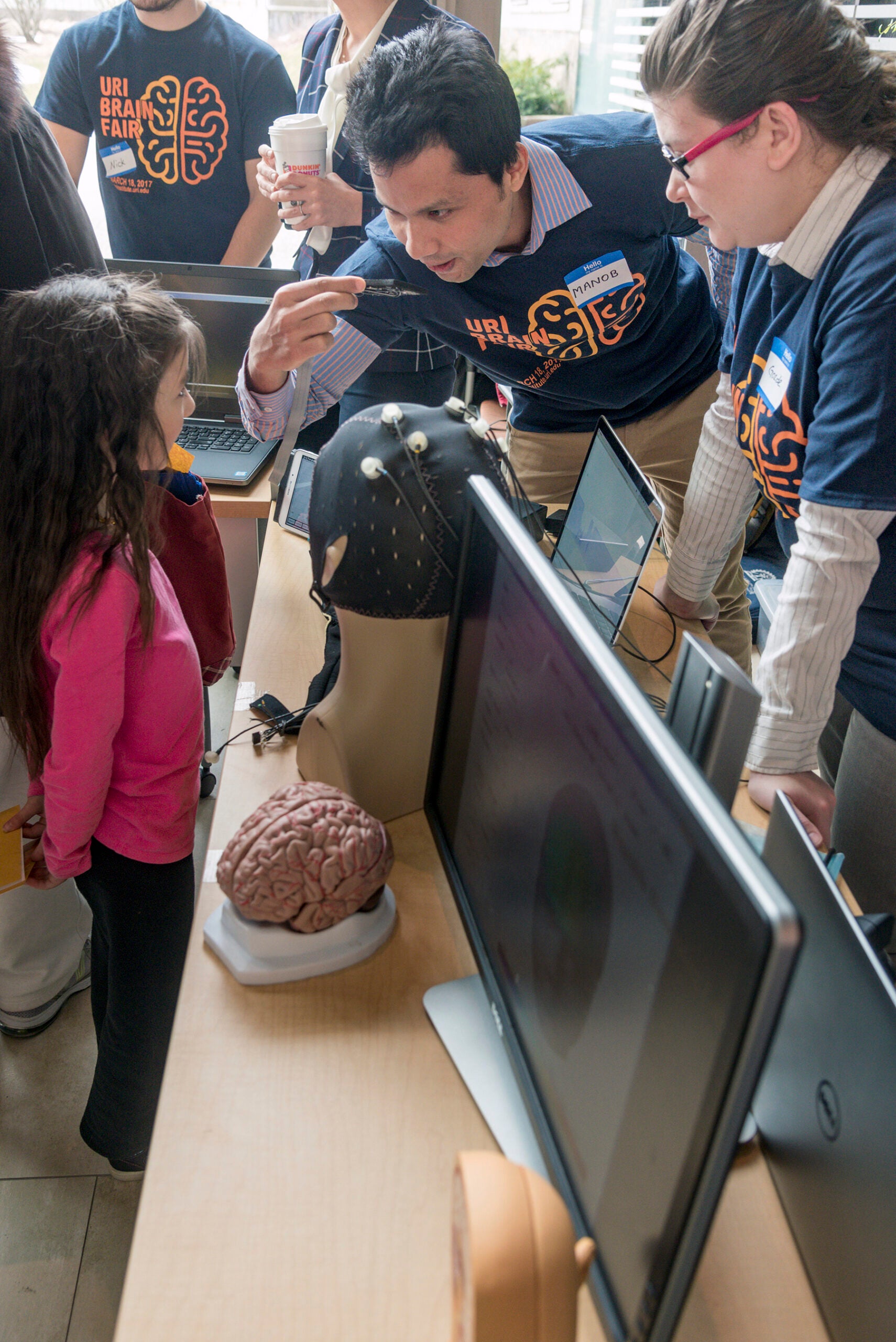KINGSTON, R.I., March 24, 2017 — The University of Rhode Island’s motto is Think Big, We Do; and the results of some of that big thinking were evident at the URI Brain Fair, which brought some 500 people to campus March 18.
The free, interactive, family-friendly event sponsored by URI’s George & Anne Ryan Institute for Neuroscience featured researchers, faculty, staff and students from several programs and departments, including members of the Colleges of Health Sciences, Nursing and Pharmacy — which form the Academic Health Collaborative — as well as Engineering, Business Administration and Arts and Sciences.
They demonstrated creative approaches to brain science, showcased URI research into brain diseases and illustrated simple ways to protect brain health, said Paula Grammas, executive director of the Ryan Institute. The event is just one of the Institute’s multi-disciplinary efforts to advance neuroscience and engage the public.
“The Ryan Institute is targeting new ways to treat and cure disorders such as Alzheimer’s disease, Parkinson’s disease, and more,” said Grammas. “We have exciting leads on a number of new therapies, but in the meantime, it’s important for people to know what they can do now, today, to keep their brains and bodies as healthy as possible.”
Adults and children packed the College of Pharmacy atrium, where they tried to balance on surfboard simulators while kinesiology faculty explained how the brain and body work together to allow us to “catch a wave.”
Nearby, psychology graduate students Alison McCallum of Bristol and Alyssa Francis of East Providence presented brain teasers and puzzles that tested flexible thinking, impulsivity and memory. “Everyone can practice these skills,” Francis said. “Some people are getting discouraged, and we are encouraging them to think differently than they do.”
Elsewhere, kids built brain cells out of pipe cleaners or candy, painted tiny models of the brain or chose to have brightly colored neurons painted on their faces.
In the 3D printing and molecular modeling studio, pharmacy student Robby Rocchio and nursing student Abby Cleland, both of North Kingstown, explained how the technology makes abstract concepts tangible. “A lot of people are really surprised we are able to print out these complex structures,” said Cleland, as the 3D printer churned out one of 857 sheets of material to create a model of a cholesterol-lowering drug.
In the 3D Visualization Theater, pharmacy Professor Bongsup Cho and student Rachel Carley of West Greenwich had audience members don glasses for a journey that zoomed around the brain and explored DNA and viruses. Rylan Wetherbee, 8, of Coventry, who attended with his parents, immediately recognized the Zika image as a virus. “Since my dad’s a chemist, he taught me a lot about science,” explained Rylan, who plans to be a scientist when he grows up. “I’ll be all different kinds: seven scientists, a different one each day of the week.”
In a quiet room at the end of a hall, father and daughter Doug and Katie Deboer of South Kingstown experienced a darker side of the brain. They took “A Walk in Their Shoes,” a sensory simulation of what it is like to live with dementia that is designed to increase awareness and empathy. The Alzheimer’s Association of Rhode Island and The Lighthouse at Lincoln — an assisted living facility for those with dementia and memory impairment — presented the encounter.
“It was unexpected, especially with the headphones,” Katie Deboer said of the discordant mix of sounds that simulated the auditory distortion often experienced by those with advanced dementia.
Glasses that impaired vision, gloves that stymied the execution of simple household tasks and shoe inserts that made walking uncertain contributed to the unsettling experience. “If people really do experience all of that at once, it’s got to be unbearable,” Doug Deboer said.
A world away from the sensory confusion of dementia, Audrey Cardany, associate professor of music education, and her students led musical jams to demonstrate what happens in our brains when we make music, listen to it or move to it. “We don’t have a music center in our brain so it’s a full brain workout. That’s why it is so beneficial,” she said. “Being in the presence of music lights up your brain.”
Best of all, virtually everyone enjoys music, making this brain health prescription easy to fill. “It’s one of the few things in life that is enjoyable and is inherently good for you,” Cardany noted. “It’s a little different than ‘you have to eat those Brussel sprouts.’”
(See a gallery of photos depicting activities at the URI Brain Fair.)

